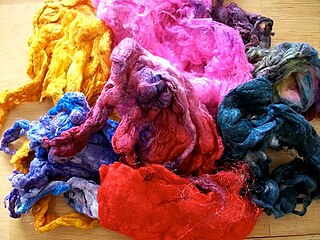Slub (textiles)
Thicker section of yarn, thread or fiber From Wikipedia, the free encyclopedia
Thicker section of yarn, thread or fiber From Wikipedia, the free encyclopedia
A slub in textiles production refers to thickened areas of a fiber or yarn. Slubbed or slubby fabric is woven from slubby yarn (yarn with a very variable diameter). Both high and low slubbiness may be sought.
This article needs additional citations for verification. (April 2022) |

Slubs in spun fibers may be produced deliberately by varying spinning tension (see Novelty yarns#Slub). They are also produced when short, staple fibers are spun into a single yarn. Slubs may be valued or deliberately produced for aesthetic effect, but they may also be regarded as a defect caused by either uneven spinning or using low-grade, lumpy or short-staple fiber.
Slubby cotton fabric includes:
Linen is often slubbed. Wool fabrics, such as tweeds, may also be slubbed.[1]


Silk is a filament fiber, and the only natural fiber type to come in filament length naturally (strands can be over 1.5 km long). However, some silk fibers are shorter in length, and must therefore be processed as shorter-staple fibers, not as filament fibers, to make cloth. These shorter fibers, known as silk noil, may also be used unspun (for instance, as wadding in a quilted garment), but are often plied into threads (which are then at least twice as thick as the filament) and used in the production of slubbed silks. Slubbed silks include:
Slubby mixed-fiber fabric include:
Synthetic fibers can readily be produced in filament form, as very long lengths of consistent diameter, but it is sometimes slubbed for effect.[2]
Seamless Wikipedia browsing. On steroids.
Every time you click a link to Wikipedia, Wiktionary or Wikiquote in your browser's search results, it will show the modern Wikiwand interface.
Wikiwand extension is a five stars, simple, with minimum permission required to keep your browsing private, safe and transparent.